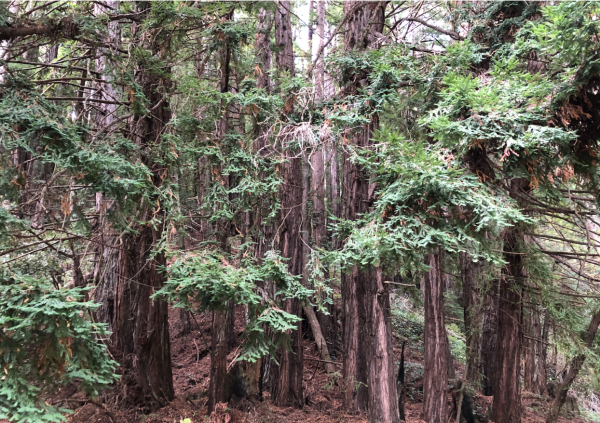
The 4,000 acre Butano State Park is located in the mountains near Santa Cruz. It was originally the land of the Quiroste Tribe, who would use controlled burns to keep the forest’s biodiversity and tree populations in check. Controlled burns clear dense undergrowth that wildfires feed on, and return nutrients from dead flora to the soil.
There are two main tree species in Butano State park — Douglas fir and redwood. However, logging efforts in the 20th century destroyed the redwood population as emerging large machinery made the process easier. While both types of their wood have a variety of uses, logging Douglas firs was not profitable at the time. This continued until 1956 when the land was bought by California State Parks, which aimed to protect the forest from more tree loss. The approach they took was to leave the forest alone and let nature take its course, which only caused more damage as the redwoods could not get the resources they needed to grow. The taller Douglas-firs blocked out the sunlight they needed, and the vast root system of the Douglas-firs blocked the redwoods from getting nutrients from the soil. In order to address this issue of redwood loss, the state of California has recently been taking greater care of growing redwoods in Butano State Park so that the balance between these species can be restored.
My fellow peers and I, five classmates all interested in this issue, intended to solve this problem. First, we measured several statistics in randomly chosen quadrants in Butano State Park. Some of these statistics included basal area (the cross sectional area of trees at 4.5 feet tall), tree density, and tree height. From this, we could determine the tree density and amount of lumber present, and create a plan to restore the redwood population.
After speaking to several professional licensed foresters, we then developed several strategies to reduce the Douglas fir population — not only reducing competition for the redwoods, but also reducing the risk of devastating fire — in a way that would both be the most cost efficient and be as environmentally friendly as possible. We intended to secure funding from the California Department of Forestry and Fire Protection (CalFire). The state of California gives CalFire allotted money for their grant distribution to projects and parks that they feel would benefit California the most.
Our first strategy was to log Douglas firs and sell them. This would allow us to gain some return on money from selling the wood, and preserve the carbon dioxide inside of the logs. Carbon dioxide is a greenhouse gas, which contributes to global warming. However, the nearest mill that would process Douglas firs is a six-hour round trip away. Most grants from CalFire also do not allow profit to be made from selling lumber.
Finally, we found chipping the logs and spreading a thin layer of chips on the forest floor was the best method to eliminate overcrowding of douglas-firs. It was significantly cheaper than commercializing the douglas-fir logs. The chips would also eventually decompose, returning most of the nutrients back to the soil.
It is important to note that the solutions to big problems like these are rarely this simple. These solutions were hypothetical, and there would probably be many additional problems, such as rough terrain and bad weather. Despite these challenges, we can all work together to create more sustainable practices and a healthier environment.
